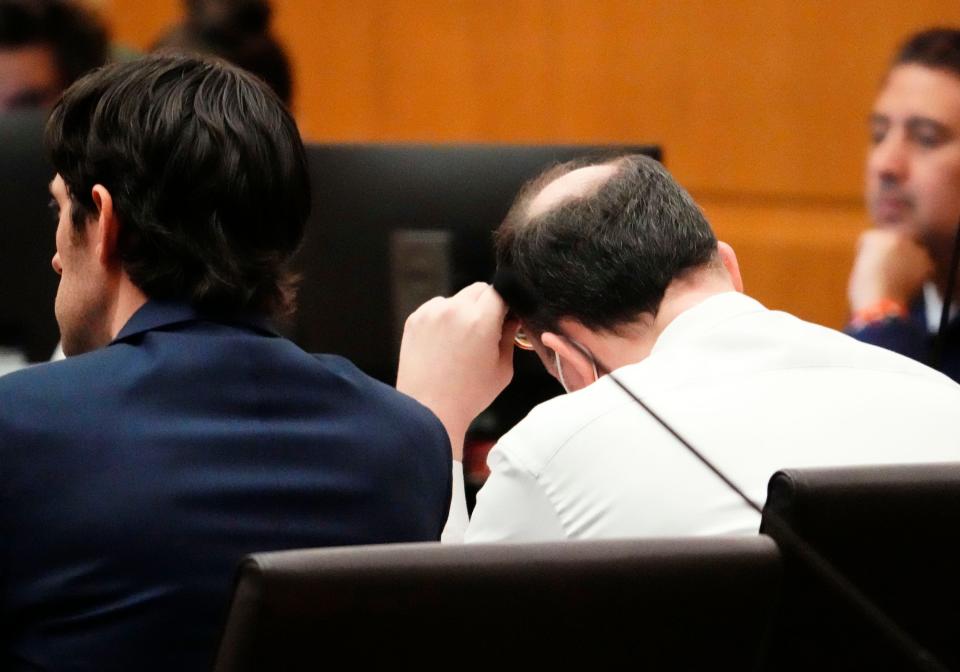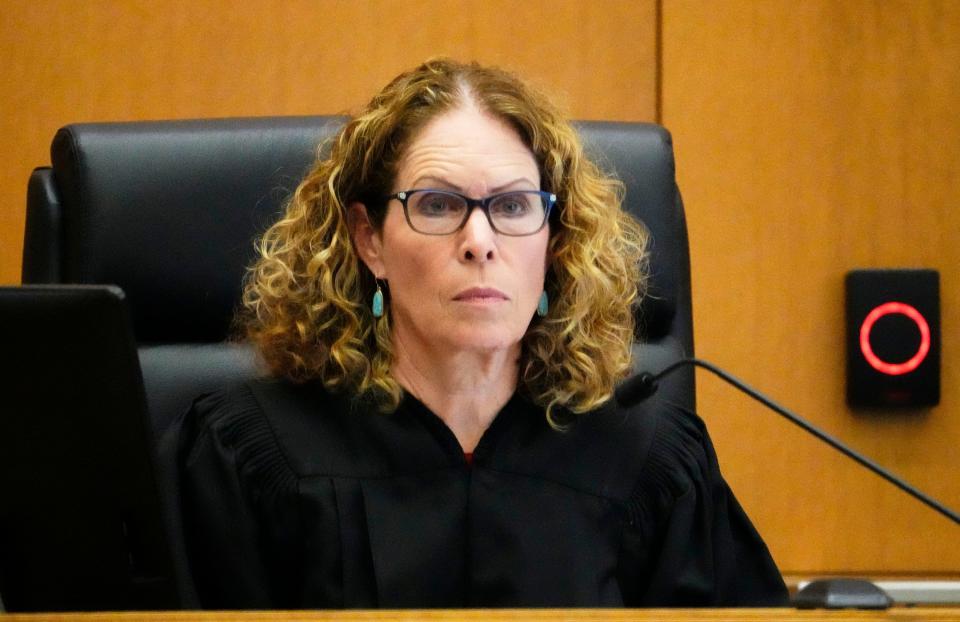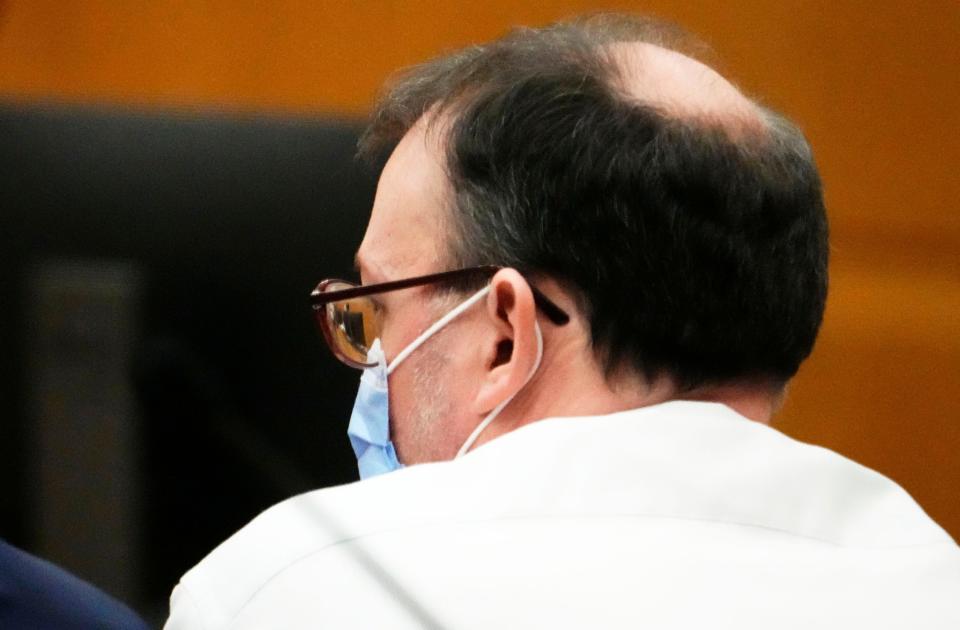Attorneys outline arguments in the trial of the man accused in the Phoenix 'canal killings'
The murder trial had been decades in the making.
“I actually hadn’t really thought about it until early this morning,” said prosecutor Vince Imbordino as he started his opening statement Monday.
On Nov. 8, Imbordino said, it will have been 30 years to the day since Angela Brosso was murdered.
About 10 feet behind him, in the spacious downtown Phoenix courtroom, sat the man accused of killing her: Bryan Patrick Miller.
Flanked by his defense attorneys, he was dressed in a white button-down shirt and glasses, his expression concealed behind a blue surgical mask.
Prosecutors say he murdered Brosso and teenager Melanie Bernas in two separate killings, 10 months apart, in the early 1990s. Known as the "canal killings," because of where the victims were found, the brutal crimes terrified Phoenix before going cold for 22 long years.

He faces two counts each of first degree murder, kidnapping and attempted sexual assault.
Miller says he is not guilty due to insanity. He was charged in 2015, but his attorneys did not invoke the insanity defense for six years, until July 2021.
He can't remember what happened the nights Brosso and Bernas died, said his attorney Denise Dees.
But Miller's family and friends and expert witnesses are expected to testify that the man sitting in court Monday "is not the Bryan who committed these horrible offenses."
Everyone had questions after the murders, Dees said. “Why did this happen? How did this happen?”
Miller had the same questions, Dees said. And to find the answers, the defense will go back more than 30 years, to his childhood.
The murders
On Nov. 8, 1992, Angela Brosso left her apartment near Interstate 17 and Cactus Road for a bike ride. She was about to turn 22, but would never make it home.
"Murdered doesn't really describe what happened to her," Imbordino said in his opening statement. Officers searching for her the next morning came across a trail of blood leading off the bike path, strewn with purple scraps of Brosso's slashed clothing.
At the end of the trail was Brosso's body, wearing only tennis shoes and socks. She had been decapitated, her nude torso subject to so frenzied an attack that she was almost cut in half at her waist.
One stab wound to her left back, so forceful that it sliced her aorta and lung and fractured a rib, had been delivered before she died, Imbordino said.
A post mortem examination could not determine when others were inflicted. There were just too many of them.

Her head was found in the canal 11 days later. It is likely, Imbordino said, that it flowed downstream with the water, passing under the I-17 before getting caught in a grate by the Metrocenter mall.
It was unclear, he added, when her head was placed in the canal.
Ten months later, Melanie Bernas's body was found floating in the same canal, close to where Brosso's head was recovered.
She had also been stabbed in the back, a deep wound that pierced her lung and aorta. But her other wounds were different: A cross and initials had been carved into her chest.
Some clothing and part of her Walkman headphones were discovered under a bush. More clothes and the rest of the headphones were discarded in a nearby trash bin. Her bra was dropped on the path and the Walkman never found.
Her body had been re-dressed in a turquoise body suit, Imbordino said.
Semen was discovered on vaginal swabs from both women, as well as on their clothes. The sample languished for years without progress, but in 2015, Imbordino said, it was matched to Miller.
The plan
In 1990, Imbordino said, when Miller was in his late teens, his mother found a document written by her son that disturbed her so much she alerted Phoenix Police.
Prosecutors call it The Plan, though Miller didn't give it that heading. The target of The Plan was a girl of about 17, Imbordino said.

It laid out what Miller would need: a carving knife, a garbage bag for body part disposal, a container for blood, gloves, and a black hood.
And, he said, it laid out what Miller wanted to do: "Kidnapping a young woman, cutting her clothes off, committing multiple acts of sexual assault, cutting her to scare her, killing her by slicing open her belly, reserving the head to look at in the future."
Some call it a fantasy, Imbordino said, and it may have been. At one time.
"Unfortunately," Imbordino said, "that fantasy became a very harsh reality."
The insanity defense
Miller's insanity defense rests on two diagnoses.
At the time of the murders, Dees said, he was suffering from an unspecified dissociative disorder and autism spectrum disorder.
As a child, Dees said, Miller lived in Hawaii, he and his mother on one island and his father, in the army, on another. When Miller was five, his father died in a motorbike accident.
His mother, Dees said, resented Miller for getting in the way of her starting a new life with a new man. And that resentment was expressed through abuse.
"He was terrified of his mother," she said.
Miller was literally treated like a dog, she said, forced to walk on all fours and eat out of a bowl. There would be evidence that he was beaten, and frequently left at home alone as his mother worked nights or went out.
"He turned inside of himself and created his own little world," Dees said. "There he could separate himself from the abuse, distance himself from the trauma."
That's when Miller began to disassociate, she said.
At 10, Miller and his mother moved to Phoenix. In Arizona, Dees said, the abuse worsened and took on a sexual dimension, Miller's mother exposing him to sexually violent films that imprinted on his young mind.
She said Miller's mother brazenly screened "mondo documentaries" in front of her son, films designed to shock and terrify and violate social norms.
For Miller, Dees said, the films were doubly hard to comprehend as he has autism spectrum disorder. They led to disturbing fantasies, and when Miller's mother threatened to cut off his penis, he believed that she would.
In May 1989, Dees said, a 16-year-old Miller took the bus to Paradise Valley Mall instead of school.
He disembarked with a young woman he had never met or seen before, she said, into a crowded public area around 8:30am.
He stabbed the young woman in the back before "snapping out of it" and running away, Dees said.
"It was almost like it wasn’t him," she said. "And you’ll hear him say that it was like being on a computer with someone else having control of the mouse."
Her opening statement rested heavily on the concept of two Millers: "normal state" Miller and "trauma state" Miller.
The man sitting in court would be described as a "caring father" and "friend to many", she said, a quiet, shy and socially awkward man.
"Everyone who takes the stand will talk to you about the Bryan they know, not the Bryan who committed these horrible offenses."
Disassociating is how he copes with his trauma, she said.
"When this happens, it's not 'normal Bryan,'" Dees said. "There's no regulation."
Reach the reporter at lane.sainty@arizonarepublic.com. Follow her on Twitter @lanesainty.
This article originally appeared on Arizona Republic: Attorneys outline arguments in the trial of the accused 'canal killer'

